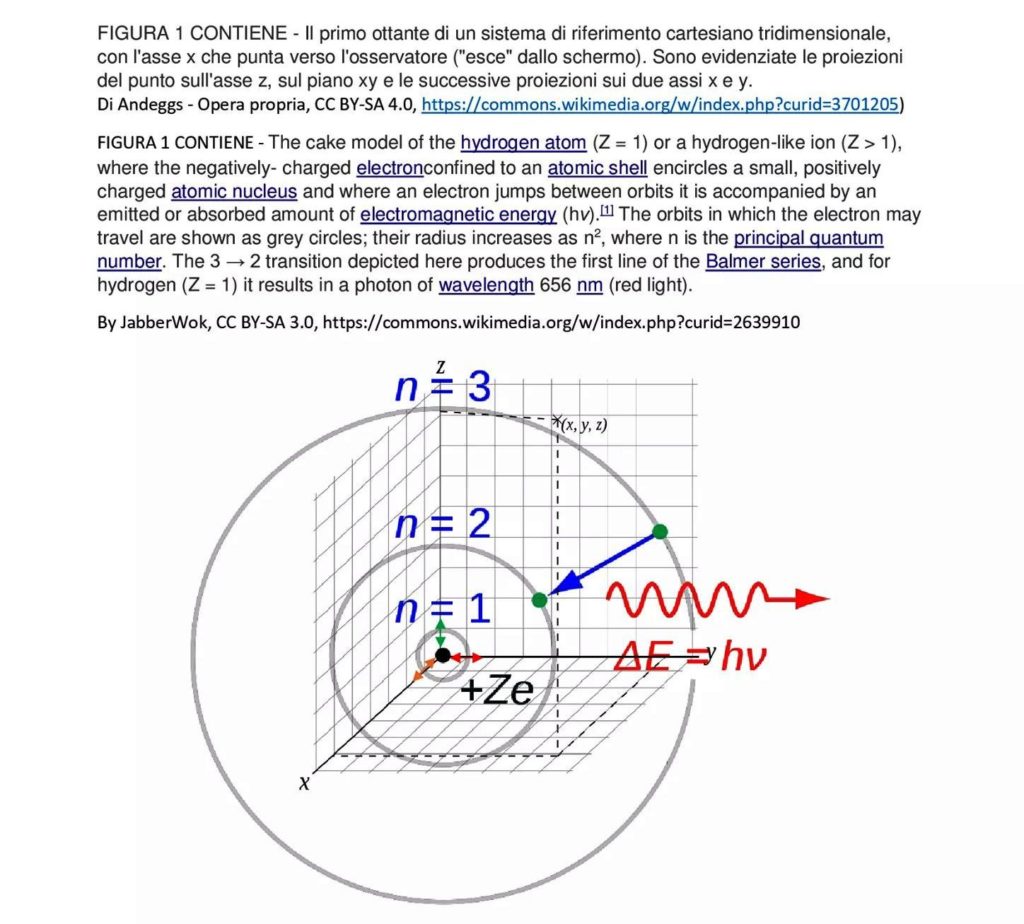L’atomo dei miei sogni – Parte 1

il primo ottante di un sistema cartesiano tridimensionale
Immaginate il nucleo al centro degli assi cartesiani x,y,z piccolo, in scala 1 mmc, mentre lo spazio orbitale si estende 10000 mmc. Il nucleo che oscilla dilatandosi e restringendosi in continua successione molto velocemente. Questa oscillazione armonica determina il campo eletrico e magnetico intorno al nucleo disegnando gli orbitali. Immaginamo per il momento i 7 orbitali s sferici ma con raggio crescente. Il primo orbitale 1s vede il disegno sferico fino al nucleo . L’elettrone non cade in condizioni di normalità poichè viene diretto dal campo magnetico e elettrico che si forma nello spazio circostante . Inoltre ammettendo la presenza di cariche negative nel nucleo (teoria dei quark ) le cariche negative dal centro del nucleo (punto iniziale della oscillazione armonica principale) si rovesciano all’esterno della sfera nucleare creando una barriera di potenziale che frena il moto dell’elettrone verso il nucleo positivo. Queste due forme di energia (elettromagnetica e la barriera di potenzale sono il carburante dell’elettrone circolante. I gusci successivi di tipo s sono meno energetici allontanandosi dal nucleo fino a E=0 a raggio infinito. Questa descrizione non è sufficiente a spiegare i fenomeni atomici poichè dobbiamo tenere conto dell’interazione di altri atomi circostanti con perturbazioni di nuclei vicinali e elettroni che si interscambiano continuamente.
———————————-
The atom of my dreams – Part 1
You imagine the nucleus at the center of small sphere 1 mmc, in the cartesian axes, while the orbital space extends 10000 mmc. The nucleus that oscillates dilating and shrinking in continuous succession very quickly. This harmonic oscillation determines the eletrical and magnetic field around the nucleus by drawing the orbitals. Imagine for the moment the 7 orbital s spherical but with increasing radius. The first orbital 1s sees the spherical design up to the nucleus. The electron does not fall into normal conditions because it is directed by the magnetic and electric field that is formed in the surrounding space. Furthermore, by admitting the presence of negative charges in the nucleus (quark theory), the negative charges from the nucleus of the nucleus (initial point of the main harmonic oscillation) are reversed outside the nuclear sphere creating a barrier of potential that brakes the motion of the electron towards the positive nucleus. These two forms of energy (electromagnetic and the poten- tial barrier are the fuel of the circulating electron.The successive s-type shells are less energetic moving away from the nucleus up to E = 0 at infinite radius.This description is not sufficient to explain the phenomena atomic because we must take into account the interaction of other surrounding atoms with perturbations of neighboring nuclei and electrons that continuously interchange.
Di: R.Z. (Comitato Scientifico C.I.R.)
By: Centro Italiano Ricerche
———————————-
FIGURE UNITE
FIGURA 1 CONTIENE – Il primo ottante di un sistema di riferimento cartesiano tridimensionale, con l’asse x che punta verso l’osservatore (“esce” dallo schermo). Sono evidenziate le proiezioni del punto sull’asse z, sul piano xy e le successive proiezioni sui due assi x e y.
Di Andeggs – Opera propria, CC BY-SA 4.0, https://commons.wikimedia.org/w/index.php?curid=3701205)
FIGURA 1 CONTIENE – The cake model of the hydrogen atom (Z = 1) or a hydrogen-like ion (Z > 1), where the negatively- charged electronconfined to an atomic shell encircles a small, positively charged atomic nucleus and where an electron jumps between orbits it is accompanied by an emitted or absorbed amount of electromagnetic energy (h?).[1] The orbits in which the electron may travel are shown as grey circles; their radius increases as n2, where n is the principal quantum number. The 3 ? 2 transition depicted here produces the first line of the Balmer series, and for hydrogen (Z = 1) it results in a photon of wavelength 656 nm (red light).
By JabberWok, CC BY-SA 3.0,







